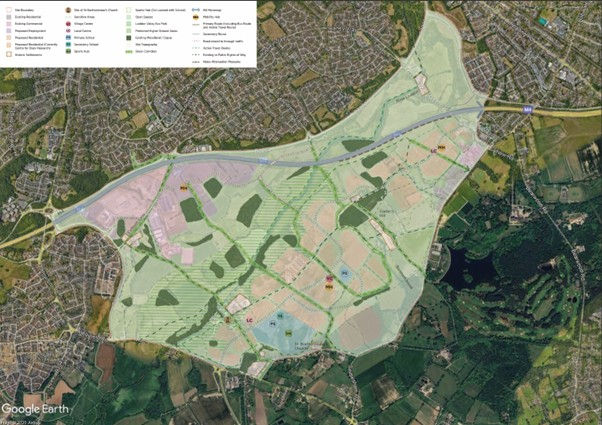Further alternatives to yet more housing at Hall Farm
- paulstevens24

- Dec 29, 2021
- 4 min read
Ahead of the SOLVE Hall Farm Working Party to be held at Arborfield Village Hall on Saturday 15th January a few more ideas for alternatives to selling the site to developers for housing:
A "Green Burial Site". Again this might seem an unusual suggestion but that is the point of creative ideas, they need to be (forgive the expression) outside the box. A quick search for Green Burial Sites near me brings up this one at the Sustainability Centre in Hampshire. Before you know it, more ideas for Hall Farm! The whole site is full of inspiration, particularly appropriate to the University of Reading which claims "We are committed to play our part in tackling climate change and are recognised as a University that leads on global environmental sustainability"
A Sustainability Centre like the fantastic model above. To quote from their site: "Sustainability is about treating the Earth as if we intend to stay. But it doesn't only mean living in a 'green' way. It asks searching questions about how we can balance economic, social and environmental factors to create a better world for everyone in it. The realities of climate change, drought, dwindling resources, wasted energy, conflict and social injustice are becoming more and more pressing. We believe we can all make the decision to live in a way that's better, greener, happier and more just". Please take the time to take a look, maybe even pay them an actual visit. Truly inspirational!
An orchard. I have a few apple trees, I also collect apples from my neighbours. Then I use my apple scratter and press to make apple juice and cider. The process is wonderfully rewarding from the apple blossom in the spring to the long cool drink in the autumn. It is very easy to do and the equipment required is very simple. Now factor in the other benefits of an orchard: Carbon capture, CO2 sequestration, soil improvement, noise mitigation and last but not least an uplifting place to restore the soul. Good quality organic cider and apple juice can fetch a good price too.
New Model Farming. Highly appropriate given that the site was a Model Farm before the site was acquired by UoR. A recent study shows that farmers who embrace sustainable cultivation measures like soil tillage and the incorporation of prairie strips and hedgerows into their fields, are able to maintain their crop yields. What’s more, in several cases these greener measures actually increase production. The international team of researchers identified six fundamental sustainable farming methods, including the diversification of crop species, adding wildlife habitat to farmland, reducing soil tillage, and enriching soil with organic matter.
Anaerobic digestion is a ‘natural ally’ for UK farmers under pressure to adopt sustainable farming practices, says the Anaerobic Digestion and Bioresources Association (ADBA). By transforming methane-emitting agricultural wastes into, on the one hand, green energy to power both machinery and premises and, on the other, digestate to restore our soils, anaerobic digestion (AD) is a natural ally for UK farmers under pressure to adopt sustainable farming practices. Selling the biogas produced into the grid also helps diversify their income. At national level, AD helps reduce the sector’s greenhouse gas emissions at a time when decarbonisation of agriculture is high on the agenda.
Silviculture is the care and cultivation of woodlands (as opposed to arboriculture which is the care and cultivation of individual trees.) There is a wide range of different silvicultural systems which are, broadly speaking, management prescriptions for particular types and areas of woodland. Forestry, at its most basic level, is the interaction between tree species, site characteristics and a silvicultural system.
County farms are farms owned by local authorities. They were set up originally at the end of the 19th century to provide a way into farming for cash-strapped young farmers during a long agricultural depression, and were sometimes rented out at below market rates. Today, they remain one of the most powerful levers that a local authority has for directly helping new people into farming. They are a national public asset and in England alone cover a huge 200,000 acres. As such they have real potential to support the economic viability of local farming, to promote innovative farming methods, and to deliver environmentally sustainable farming.
Circular accommodation. University of Greenwich has accompanied the pilot case-organisation “Paardekreek” in building a truly circular camp-site accommodation in the Netherlands. The circular aspect, and particularly the reduction of waste within the building process, were prioritised. Therefore, the soil from the dike, was reused for a nearby project. In doing so, Co2 emission of the lorries collecting the soil were kept to a minimum, and the amount of wasted soil reduced. Furthermore, the accommodations are built with a special concrete material that can be stacked in each other. In doing so, the accommodation could be dismantled should there ever be the need. The accommodation is all built from recycled and re used material. This site is used for tourists, but equally it could be used for students, visitors or even temporary workers?
Just a thought, but as much of it's a flood plain and very boggy, could the Loddon Valley be used to create a peat bog? (Even better carbon capture than trees!). Or willow grows fast, grow bio-fuel?

Please email your ideas for affordable and sustainable alternatives to housing at Hall Farm to sustainableandaffordable@gmail.com Thank you.




Comments